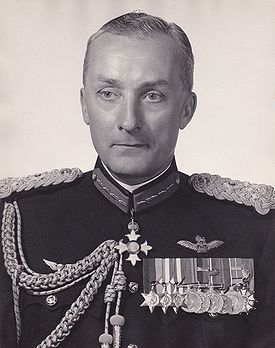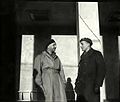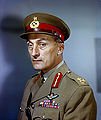Wrinch, Arthur Egbert
| Arthur Egbert Wrinch | |
|---|---|
| 13 November 1908 – 20 July 1985 | |
 | |
| Place of birth | Hazelton British Columbia |
| Place of death | Toronto Ontario |
| Allegiance | Canada |
| Service/branch | Canadian Army |
| Years of service | 1927 - 1963 |
| Rank | Major-General |
| Awards | CBE, CD |
Personal Life
Arthur Wrinch was the son of Rev. Horace C. Wrinch, M.D., D.D., a medical missionary, and grew up in Hazelton, B.C. He attended Hazelton Public School, Prince of Wales School in Vancouver (Junior Matriculation) and the University of British Columbia (Senior Matriculation) where he graduated in 1926. He married Madalene Wightman of Ottawa in 1937 and together they had one son.
Service
Wrinch entered the Royal Military College in 1927 and was assigned college number 2011. Upon graduation in 1931 he was commissioned as a Lieutenant in the Permanent Active Militia but his training had to be paused when he soon after contracted typhoid fever. At the completion of his convalescence in 1932, he served for a year at Camp Borden. Wrinch resumed his formal education in 1933 entering Queen's University in Kingston Ontario. He graduated in 1935 with a Bachelor of Science (Electric Engineering) degree.
Captain Wrinch, having been promoted in 1937, served at Halifax Nova Scotia at the outset of the Second World War. He served successively in Eastern Fortress Establishment, Royal Canadian Signals, 6 Fortress Signal Company and as District Signalling Officer of Militia District No. 6. In 1940 Major Wrinch formed, trained and was the Officer Commanding No. 4 Squadron, 1 Canadian Armoured Division Signals (later renamed to 5 Canadian Armoured Divisional Signals), later serving as the unit Second-in-Command. He went overseas to the United Kingdom in November 1941, and by April 1942 was promoted to Lieutenant Colonel and was appointed as the Commanding Officer of 1 Canadian Corps Signals, a position he held from 6 April 1942 until 15 July 1943.[1] In July 1943 he was appointed the Commanding Officer of 5 Canadian Armoured Divisional Signals. Promoted Colonel 12 January 1945, he was appointed as the Chief Signals Officer (CSO) of 1 Canadian Corps until he returned to Canada in June 1945 for service with the Canadian Army Pacific Force.[2] Having reverted in rank to Lieutenant-Colonel upon his return to Canada, Wrinch served as the Commanding Officer of 6 Canadian Divisional Signals as the unit prepared for service in the Pacific Theater until, with the surrender of Japan on 14 August 1945, the unit was disbanded by the end of the month.[3] He was then posted to Canadian Forces Netherlands from September until December 1945.
For his service in the Second World War he was made a Commander of the Order of the British Empire[4], was Mentioned in Despatches twice, in 1945[5] and 1946[6], and was granted the United States Legion of Merit (Degree of Officer).[7]
In 1946 he reverted to the rank of Colonel and was appointed as the Director of Signals from 7 March 1946 until 16 January 1949. He attended the Canadian Army Staff College in 1949, after which he went to the Canadian Army Staff in Washington, DC. In June 1951, he was promoted to the rank of brigadier and appointed Deputy Quartermaster General. He became Deputy Quartermaster General (Development and Design) in January 1952 and was subsequently appointed Vice Quartermaster-General at Army Headquarters.
In early 1955 he went to the United Kingdom to attend the Imperial Defence College and was then appointed Commander, 1st Canadian Infantry Brigade in December 1955. While in that post he received a Suggestion Award for developing a device for use with the Slidex Code system.
In 1958 he became a qualified pilot and then assumed the appointment of Direcor General of Army Personnel in September 1958, and was appointed Director General of Survival operations in May 1959. He was promoted to the rank of Major-General and appointed Major General Survival September 1, 1959 where he was responsible for the newly created Canadian Army National Survival Programme aimed to deal with cold-war threats.
He retired from the Regular Army in September 1963 and took up the appointment of National Commissioner for the Canadian Forces.
Commander of the Order of the British Empire
His citation for his appointment as a Commander of the Order of the British Empire read:
- An officer possessed of outstanding technical knowledge, Brigadier Wrinch, the Chief Signal Officer, has made a valuable contribution to the functioning of 1st Canadian Corps. Having a wealth of practical experience, including command of both Divisional and Corps Signals units, Brigadier Wrinch has been able to ensure a high standard of communications throughout the difficult battles in the Lago Comacchio region, in spite of conditions of weather and ground which were encountered.
- His officers and men, respecting the knowledge and leadership of this officer, have striven to attain the high ideals of efficient signals communications set by him with a great measure of success.
- The cheerful and effective way with which this officer tackles any problem, lare or small, his enthusiasm and eager determination to effect every possible improvement, sets Brigadier Wrinch apart as one worthy of the highest possible praise and well worthy of any recognition he may receive.
Related Pages
- Canadian German telephone linkup Wageningen Netherlands 5 May 1945
- Royal Canadian Corps of Signals Book of Remembrance
Related Items
References
- ↑ Semaphore to Satellite, page 140.
- ↑ Semaphore to Satellite, page 182.
- ↑ Semaphore to Satellite, page 228.
- ↑ The London Gazette, Supplement 37442. 22 January, 1946. Page 634.
- ↑ The London Gazette, Supplement 37151. 26 June, 1945. Page 3386.
- ↑ The London Gazette, Supplement 37521. 2 April, 1946. Page 1715.
- ↑ 6 March 1948












